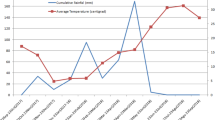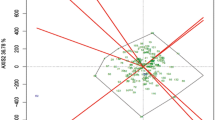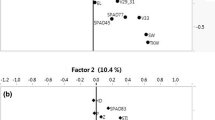Abstract
Preharvest sprouting (PHS) has been recognised as the primary cause of low falling numbers (FNs) in wheat. From recent research it is clear that there are a number of additional causes of low FNs, including late maturity α-amylase. FNs of certain cultivars have varied considerably from year to year and across environments in the wheat producing areas of the Free State Province. In this study we aimed to determine whether climatic conditions could contribute to unexpectedly low FNs. Eleven cultivars were planted over a 5 year period in five different locations in the Free State Province. Total rainfall, minimum and maximum temperatures and growing degree days were determined during six environmental periods. Results from this study indicated that rainfall during the later stages of grain filling and grain maturity had a negative effect on the FNs of 7 of the 11 cultivars, while maximum temperatures during these growing periods were positively correlated with FN in 8 of the 11 cultivars. Minimum temperatures just prior to harvest could also determine the FNs of certain cultivars. Principal component analysis identified three groupings of cultivars varying in the frequency of low FNs experienced over the 5 years of the study. It is clear from this study that rainfall just prior to harvest, and therefore PHS, was not the major factor responsible for the low FNs obtained during this study.

Similar content being viewed by others
References
American Association of Cereal Chemists (2000) Approved methods of the AACC, 10th ed. vol 11. Falling number determination. Method 56-81B. The Association, St. Paul
Barnard A (2001) Genetic diversity of South African winter wheat cultivars in relation to preharvest sprouting and falling number. Euphytica 119:107–110
Barnard A, Smith MF (2009) The effect of rainfall and temperature on the preharvest sprouting tolerance of winter wheat in the dryland production areas of the Free State Province. Field Crops Res 112:158–164
Biddulph TB, Plummer JA, Setter TL, Mares DJ (2008) Seasonal environmental conditions influence dormancy and subsequent preharvest sprouting tolerance in wheat (Triticum aestivum L.). Field Crops Res 107:116–128
Craven M, Barnard A, Labuschagne MT (2007) The impact of cold temperatures during grain maturation on selected quality parameters of wheat. J Sci Food Agric 87:1783–1793
Craven M, Barnard A, Labuschagne MT (2008) Significance of kernel moisture content in determination of Hagberg Falling Number in wheat. S Afr J Plant Soil 25(2):71–78
Dexter JE, Preston KR, Woodbeck N (2006) Canadian wheat. In: Popper L, Schäfer W, Freund W (eds) Future of flour a compendium of flour improvement. Agrimedia, Bergen, pp 43–62
Draper N, Smith H (1981) Applied regression analysis, 2nd edn. Wiley, New York, p 709
Farrell AD, Kettlewell PS (2008) The effect of temperature shock and grain morphology on α-amylase in developing wheat grain. Ann Bot 102:287–293
Gooding MJ, Ellis RH, Shewry PR, Schofield JD (2003) Effects of restricted water availability and increased temperature on the grain filling, drying and quality of winter wheat. J Cereal Sci 37:295–309
Gualano NA, Benech-Arnold RL (2009) The effect of water and nitrogen availability during grain filling on the timing of dormancy release in malting barley crops. Eyphytica 168:291–301
Hagberg S (1960) A rapid method for determining alpha-amylase activity. Cereal Chem 37:218
Joe AFTW, Summers RW, Lunn GD, Atkinson MD, Kettlewell PS (2005) Pre-maturity α-amylase and incipient sprouting in UK winter wheat, with special reference to the variety Rialto. Euphytica 143:265–269
Johannsson E (2002) Effect of two wheat genotypes and Swedish environment on falling number, amylase activities, and protein concentration and composition. Euphytica 126:143–149
Lunn GD, Major BJ, Kettlewell PS, Scott RK (2001) Mechanisms leading to excess alpha-amylase activity in wheat (Triticum aestivum, L). grain in the U.K. J Cereal Sci 33:313–329
Mares DJ (1993) Preharvest sprouting in wheat. I. Influence of cultivar, rainfall and temperature during grain ripening. Aust J Agric Res 44:1259–1272
Mares DJ, Gale MD (1990) Control of α-amylase synthesis in wheat grains. In: Ringlund K, Mosleth E, Mares DJ (eds) Fifth international symposium on preharvest sprouting in cereals. Westview Press, Oxford, pp 183–194
Mares DJ, Mrva K (1993) Late maturity alpha-amylase in wheat. In: Walker-Simmons MK, Ried JL (eds) Sixth international symposium on preharvest sprouting in cereals, St Paul, pp 178–184
Mares DJ, Mrva K (2008) Late-maturity alpha-amylase: low falling number in wheat in the absence of preharvest sprouting. J Cereal Sci 47:6–17
Mares DJ, Mrva K, Panozzo F (1994) Characterization of the high α-amylase levels in grain of the wheat cultivar BD 159. Aust J Agric Res 45:1003–1011
McMaster GS (1997) Phenology, development, and growth of the wheat (Triticum aestivum L.) shoot apex: a review. Adv Agron 59:63–118
Mitchell B, Black M, Chapman JM (1980) Drying and the onset of germinability in developing wheat grains. Cereal Res Commun 8:151–156
Nielsen MT, Mccrate AJ, Heyne EG, Paulsen GM (1984) Effect of weather variables during maturation on preharvest sprouting of hard white winter wheat. Crop Sci 24:779–782
Payne RW, Murray DA, Harding SA, Baird DB, Soutar DM (2011) GenStat® for Windows ™ (14th edition) introduction. VSN International, Hemel Hempstead
Perten H (1964) Application of the falling number method for evaluating alpha-amylase activity. Cereal Chem 41:127–140
Smit HA, Tolmay VL, Barnard A, Jordaan JP, Koekemoer FP, Otto WM, Pretorius ZA, Purchase JL, Tolmay JPC (2010) An overview of the context and scope of wheat (Triticum aestivum) research in South Africa from 1983–2008. S Afr J Plant Soil 27(1):81–95
Author information
Authors and Affiliations
Corresponding author
Rights and permissions
About this article
Cite this article
Barnard, A., Smith, M.F. Determination of the influence of climate on falling number of winter wheat in the dryland production areas of the Free State Province of South Africa. Euphytica 188, 15–24 (2012). https://doi.org/10.1007/s10681-012-0673-5
Received:
Accepted:
Published:
Issue Date:
DOI: https://doi.org/10.1007/s10681-012-0673-5




